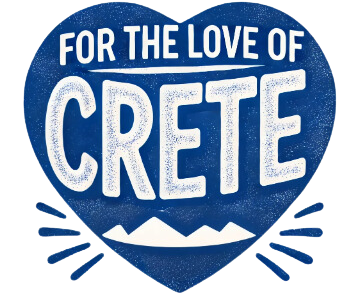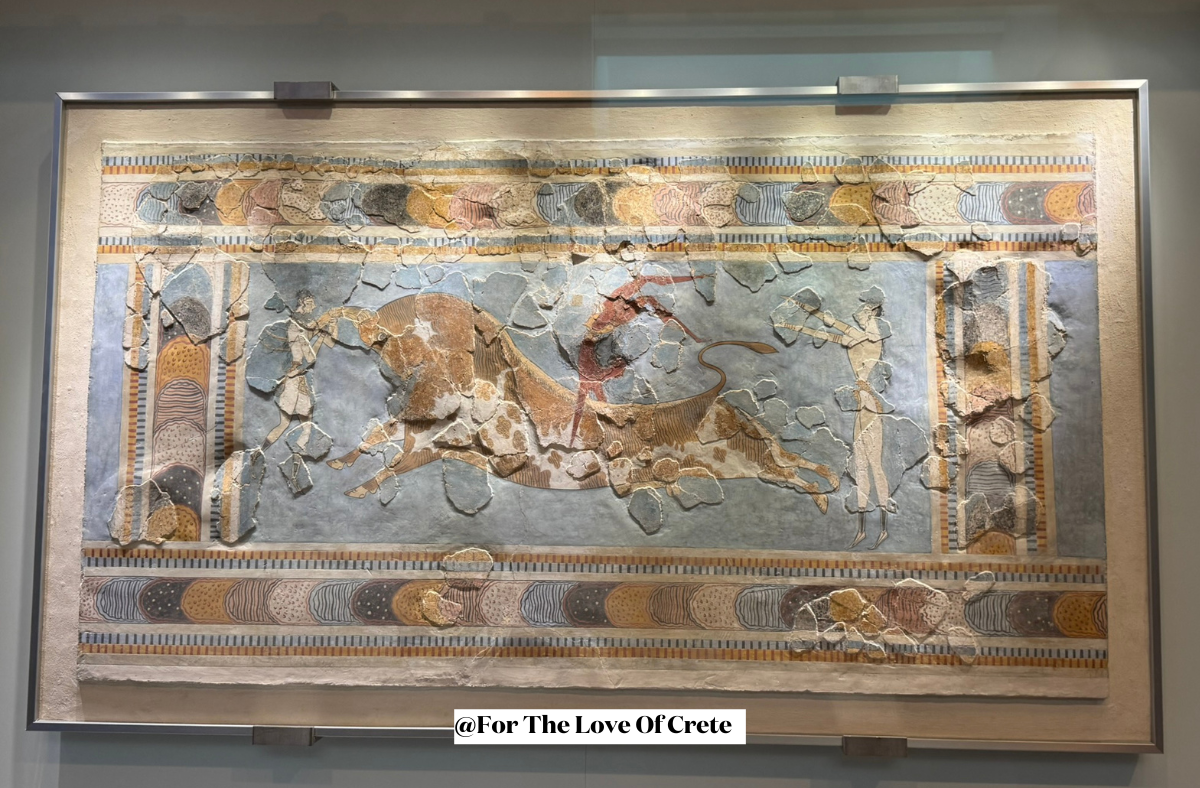Crete isn’t just another Mediterranean island dotted with beautiful beaches—it’s a cultural powerhouse that houses some of Europe’s most impressive museum collections. In 2024, museum visits across Greece surged by over 15% compared to the previous year, with the Heraklion Archaeological Museum claiming its spot as the 4th most-visited museum in Greece and the undisputed number one museum in Crete. This renewed enthusiasm for Crete’s museums highlights travelers’ growing desire for authentic cultural experiences beyond the typical sun-and-sand routine.
What makes Crete’s museum scene truly special is its remarkable diversity. You’ll find everything from the world’s most comprehensive collection of Minoan treasures—including the mysterious Phaistos Disc that still keeps archaeologists scratching their heads—to intimate mountain homes celebrating local music legends like Nikos Xilouris.
Whether you’re fascinated by 15,000 ancient artifacts spanning 5,500 years, curious about traditional Cretan crafts, or eager to explore maritime adventures and wartime stories, these 16 carefully selected museums offer genuine windows into the island’s soul.
1. Heraklion Archaeological Museum [Heraklion]
Standing as the undisputed champion of Crete’s cultural institutions, the Heraklion Archaeological Museum houses the world’s most comprehensive collection of Minoan artifacts. This isn’t just another dusty museum—it’s where 5,500 years of history come alive through thousands of carefully preserved treasures that tell the story of Europe’s first advanced civilization.
What You’ll See: The museum’s crown jewels include the mysterious Phaistos Disc (still keeping its secrets after all these years), the iconic faience Snake Goddesses, and the breathtaking Bull-Leaping frescoes from Knossos. I find myself going back to stare in awe at these frescoes whenever I’m visiting the museum, especially when no one’s waiting to snap a picture! Don’t miss the golden Bee Pendant or the richly painted Hagia Triada Sarcophagus, the only stone sarcophagus from the Bronze Age Aegean.
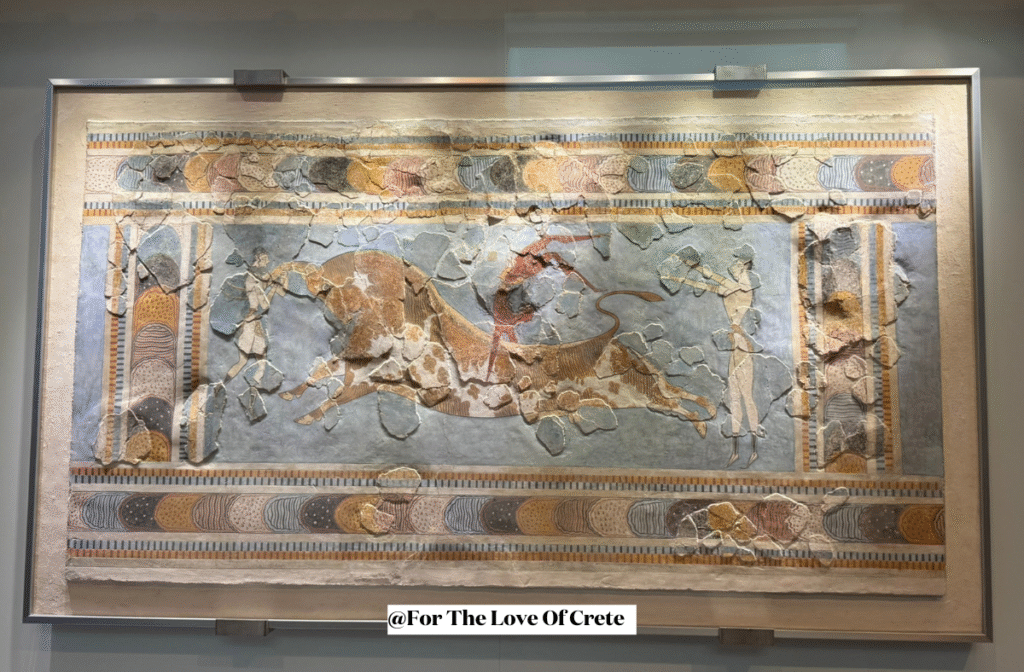
The Building: This modernist architectural landmark, designed by Patroklos Karantinos, earned a Bauhaus commendation for its innovative use of light and space. The building was constructed to be earthquake-resistant and, during WWII, the collection was safeguarded through the efforts of the museum’s director.
Visitor Experience: Many travelers actually prefer this museum over Athens’ major institutions, citing the unique appeal of Minoan art. The museum consistently ranks among Greece’s most-visited cultural sites, drawing hundreds of thousands of visitors annually.
Practical Tips:
- Time needed: Allow 2-3 hours minimum—rushing diminishes the experience
- Best deal: Grab the combo ticket covering both the museum and Knossos site
- Timing: Closes at 8pm (although it varies seasonally), but don’t arrive too late
- Location: Centrally located and easily walkable in Heraklion
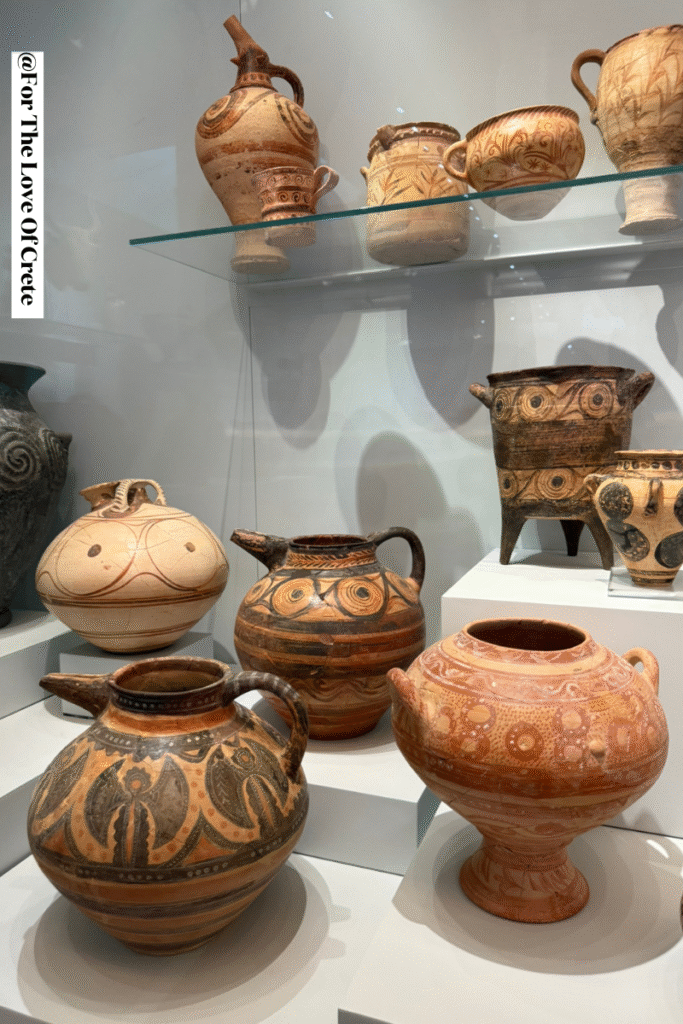
Pro tip: Some seasoned travelers consider this museum a better use of time than the actual Knossos site, especially if you want to see the most important Minoan artifacts all in one place.
2. Historical & Folklore Museum of Gavalochori [Chania]
Tucked away in the charming village of Gavalochori, this community-built gem offers something you won’t find in the grand museums: authentic Cretan village life preserved by the people who actually lived it. Since 1968, local residents have been collecting and donating family heirlooms and everyday objects, culminating in the museum’s official opening to the public in 1993. The result is a space that feels more like visiting your Cretan grandmother’s attic.
What You’ll See: The museum’s seven themed rooms showcase everything from intricate kopaneli lace wedding dresses to a practical wine press-bed combo (yes, you read that right, stomp grapes by day, sleep by night!). The massive cypress wood iconostasis on the upper floor tells a dramatic story of rescue during the Turkish occupation, while the one-armed armchair reveals the practical reality of always keeping a weapon hand free.

The Building: This historic Venetian-Turkish structure is a living example of Crete’s layered history, complete with original features like the rope for tethering donkeys at the entrance. The peaceful courtyard provides a perfect spot to digest what you’ve just experienced.
Visitor Experience: What makes this museum special is the passionate local volunteers who often staff it, sharing personal stories that bring the exhibits to life. Many artifacts come with family histories that transform simple objects into compelling narratives.
Practical Tips:
- Time needed: 1-2 hours to fully appreciate the stories
- Location: Short walk from Gavalochori’s main square
- Hours: Generally open daily from morning to early evening
- Bonus: Occasional workshops in traditional crafts like weaving and pottery
The museum adds new items yearly, so even repeat visitors discover fresh insights into this village’s remarkable heritage.
3. Eleftherios Venizelos Museum [Chania & Theriso]
Step into the remarkable world of modern Greece’s founding father through two distinct locations that tell the complete story of Crete’s most influential statesman. The Chania residence, where Venizelos lived for over 30 years, feels like stepping back in time with his original furniture, personal library, and even the car that survived the 1933 assassination attempt still on display.
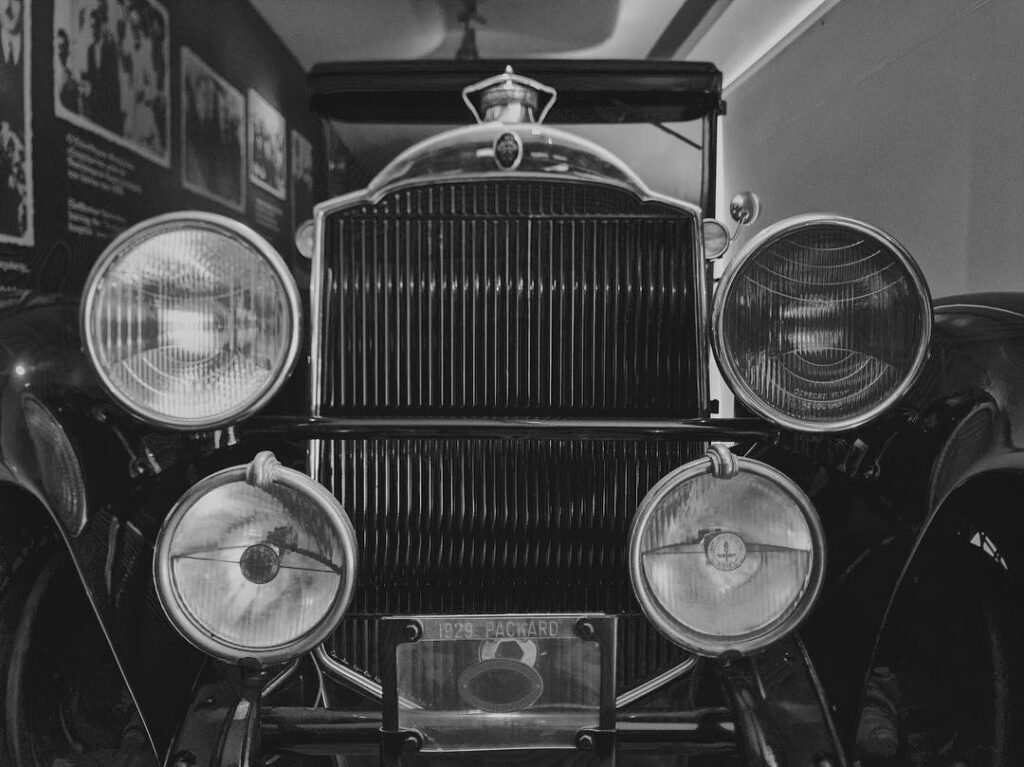
What You’ll See: The Chania museum spans 18 rooms across three floors, exploring Venizelos as “The Rebel,” “The Politician,” “The Diplomat,” “The Man,” and “The Myth.” Don’t miss the interactive attic exhibition, perfect for history buffs of all ages. Meanwhile, the Theriso museum occupies his actual revolutionary headquarters from the pivotal 1905 uprising, showcasing the original revolution flag that reads “Therisso 1905”, historic weaponry, and traditional Cretan attire.
The Experience: The Chania residence preserves many rooms as they were during Venizelos’s time, though some have been adapted for thematic exhibitions, while Theriso’s mountain setting adds dramatic context to his revolutionary activities. The fully renovated Theriso museum (reopened in 2019) features modern displays across two floors.
Practical Tips:
- Combo visit: Pair Theriso with a scenic gorge drive and lunch at Emilia’s Taverna in Zourva for breathtaking views
- Best addition: Visit the Venizelos family tombs above Chania for panoramic views
- Special events: Theriso’s August 15th festival combines history with music, dance, and local food
- Time needed: 1-2 hours per location
Both museums are managed by the National Research Foundation, ensuring scholarly presentation of one of Greece’s most fascinating political figures.
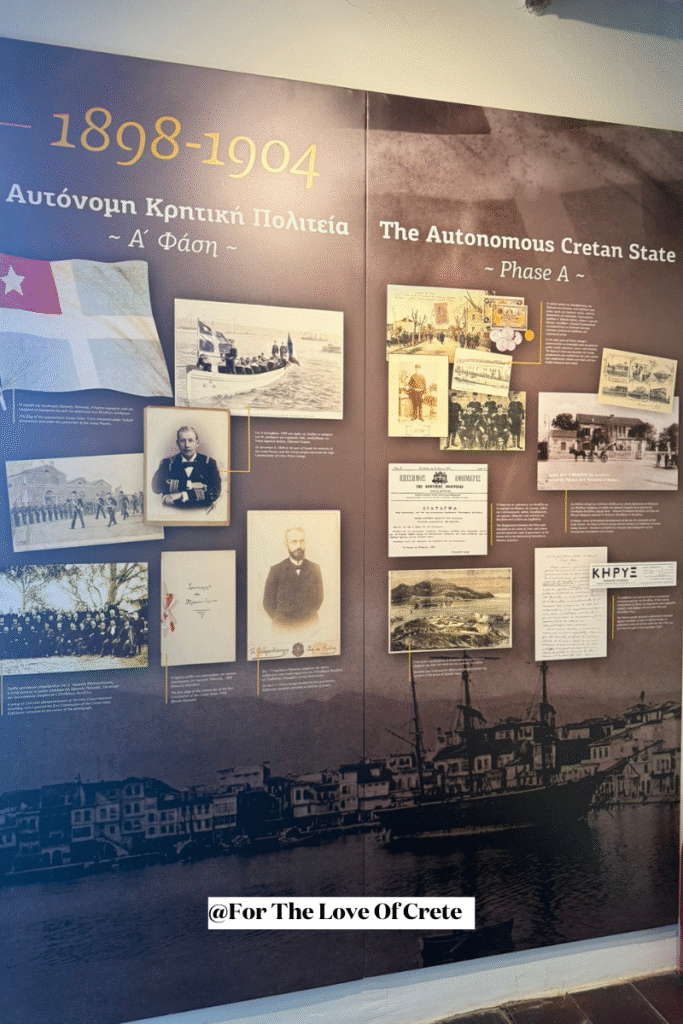
4. Nikos Xilouris House [Anogeia]
Perched at 830 meters on the slopes of Mount Psiloritis, this humble childhood home turned museum captures the spirit of Crete’s most beloved lyra player. Known as the “Archangel of Crete,” Xilouris became the voice of resistance during Greece’s darkest political hours, and his legacy lives on in this deeply personal tribute.
What You’ll See: This is not a large museum but rather a small, single-room memorial space lovingly curated by Xilouris’s sister Zouboulia. It feels more like a heartfelt shrine, displaying family photographs, cherished relics, and personal memorabilia that tell the story of this musical legend. Many visitors describe the experience as deeply moving, often finding themselves touched by Xilouris’s enduring spirit.
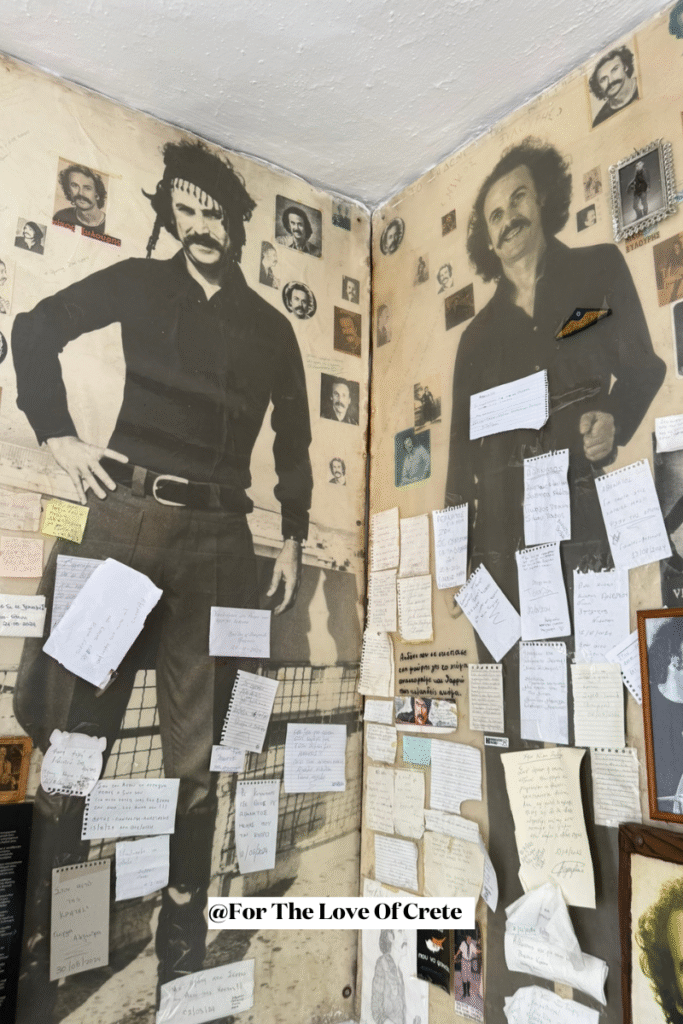
The Setting: The museum sits in Anogeia’s charming Perachori district, a village that perfectly embodies Cretan resilience. Destroyed and rebuilt three times due to its role in resistance movements, Anogeia’s heroic history provides powerful context for understanding Xilouris’s music and revolutionary spirit.
The Experience: Local cafes often play Xilouris’s music, creating an authentic atmosphere that connects past and present. The surrounding square invites you to sample traditional antikristo lamb and sweet galaktoboureko while soaking in the mountain views.
Practical Tips:
- Time needed: 20-30 minutes for the house, plus time to explore the village
- Bonus: Visit cousin Aristea’s weaving shop nearby
- Setting: The scenic mountain drive is part of the experience
5. The Nikos Kazantzakis Museum [Heraklion – Myrtia]
Nestled in the charming village of Myrtia, Nikos Kazantzakis Museum celebrates Greece’s most translated author and the creative genius behind “Zorba the Greek.” With an archive of around 50,000 documents, manuscripts, and personal items (not all on display), it stands as one of the world’s best-organized literary collections, earning the prestigious “Accredited Museum” title in 2022.
What You’ll See: The museum’s five thematic sections showcase everything from personal letters exchanged with Albert Einstein to rare manuscripts that shaped modern Greek literature. Don’t miss the models and costumes from stage and film adaptations of Kazantzakis’s works, or his correspondence with major intellectuals of his time.
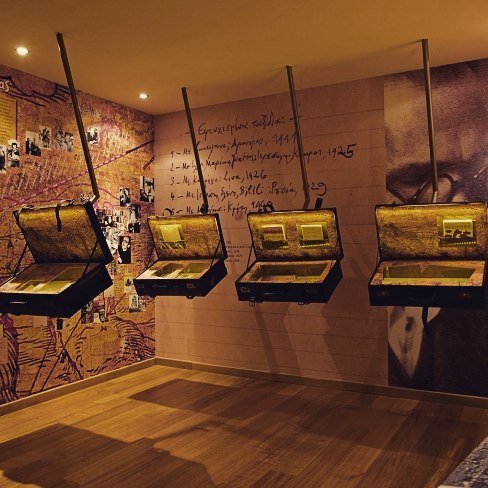
The Experience: Start with the engaging 20-minute audiovisual presentation (available in 11 languages) before exploring the state-of-the-art interactive exhibits installed during the 2009 renovation. The museum’s modern accessibility features include ramps, elevators, Braille information, and headphones for all visitors.
Village Charm: Myrtia itself enchants visitors with graffiti and murals dedicated to Kazantzakis throughout the village. The locals embody true Cretan philoxenia, often offering treats to curious visitors who stop to chat.
Practical Tips:
- Time needed: 1-2 hours for the full experience
- Must-visit: Gift shop and bookstore across the square for literature lovers
- Perfect combo: Lunch at nearby Olive and Mint in Skalani
- Hours: Daily 9:00-17:00 (April-October), shorter winter hours
The museum frequently hosts special events and an annual summer festival, making it a living celebration of Kazantzakis’s enduring legacy.
6. El Greco’s Birthplace Museum [Heraklion – Fodele]
While scholars still debate the exact birthplace of Dominikos Theotokopoulos (better known as El Greco), the charming village of Fodele proudly claims this legendary artist as its native son. The small but atmospheric museum, housed in a beautifully restored stone building, offers fascinating insights into El Greco’s Cretan roots and early life.
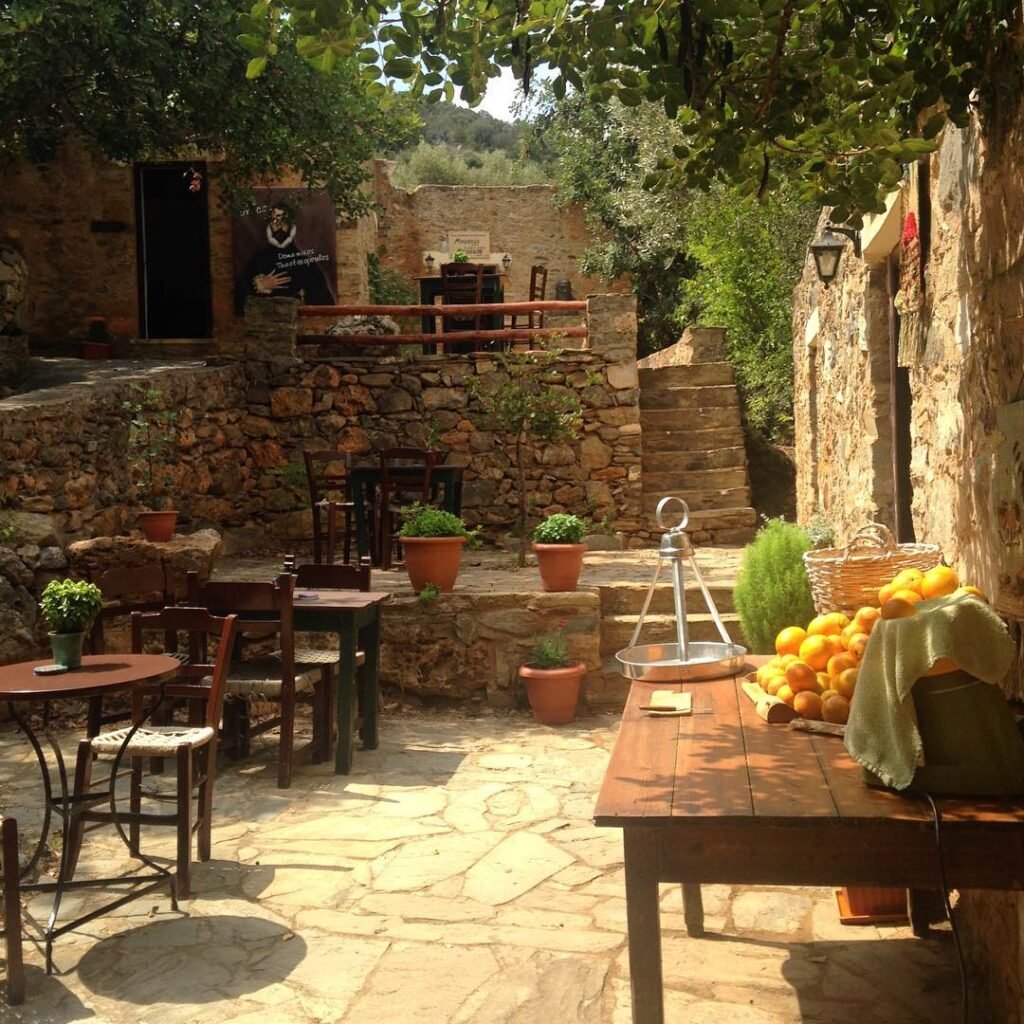
What You’ll See: The museum’s two rooms display reproductions of El Greco’s masterpieces in light boxes, alongside rare photographs and historical documents, including materials from tributes by Spanish scholars in the 1930s. A recreated artist’s atelier helps you imagine young Dominikos developing his craft in 16th-century Crete.
The Setting: Surrounded by orange groves and the lush Pantomantris River, the museum’s location transports you to El Greco’s time. The shaded courtyard café under centuries-old plane trees provides a perfect spot to contemplate what you’ve just experienced.
Don’t Miss: The adjacent Byzantine Church of Panagia with its remarkable ancient frescoes dating from the 11th-13th centuries often proves as captivating as the museum itself. Many visitors find the church equally rewarding, and it’s literally right next door.
Practical Tips:
- Time needed: Less than an hour for the museum
- Best approach: Combine with village exploration and lunch in Fodele’s inviting square
- Season: Open April-October, daily except Tuesdays (08:30-19:00)
- Modest fee: About 2.50-3€ entrance
- Accessibility note: Rough, uphill terrain
While you won’t find original El Greco works here (those are at Heraklion’s Historical Museum), this intimate setting captures the spirit of his Cretan origins.

7. Chania’s Nautical Museum [Chania]
Chania’s Nautical Museum is split between two sites: the main collection in the historic Firka Fortress at the entrance to Chania’s Old Venetian Harbor, and the Museum of Ancient and Traditional Shipbuilding in the Moro Shipyard at the harbor’s eastern end. Together, they offer one of Greece’s most fascinating maritime experiences.
What You’ll See: The main museum in the Firka Fortress houses over 2,500 artifacts and ship models, taking you on a journey from Minoan thalassocracy and Venetian naval dominance to the modern era. Highlights include meticulously crafted ship models (some taking up to two years to build), war relics from the Battle of Crete, a life-size destroyer bridge reconstruction, and a marine life section featuring exotic seashells, corals, and mounted fish specimens.
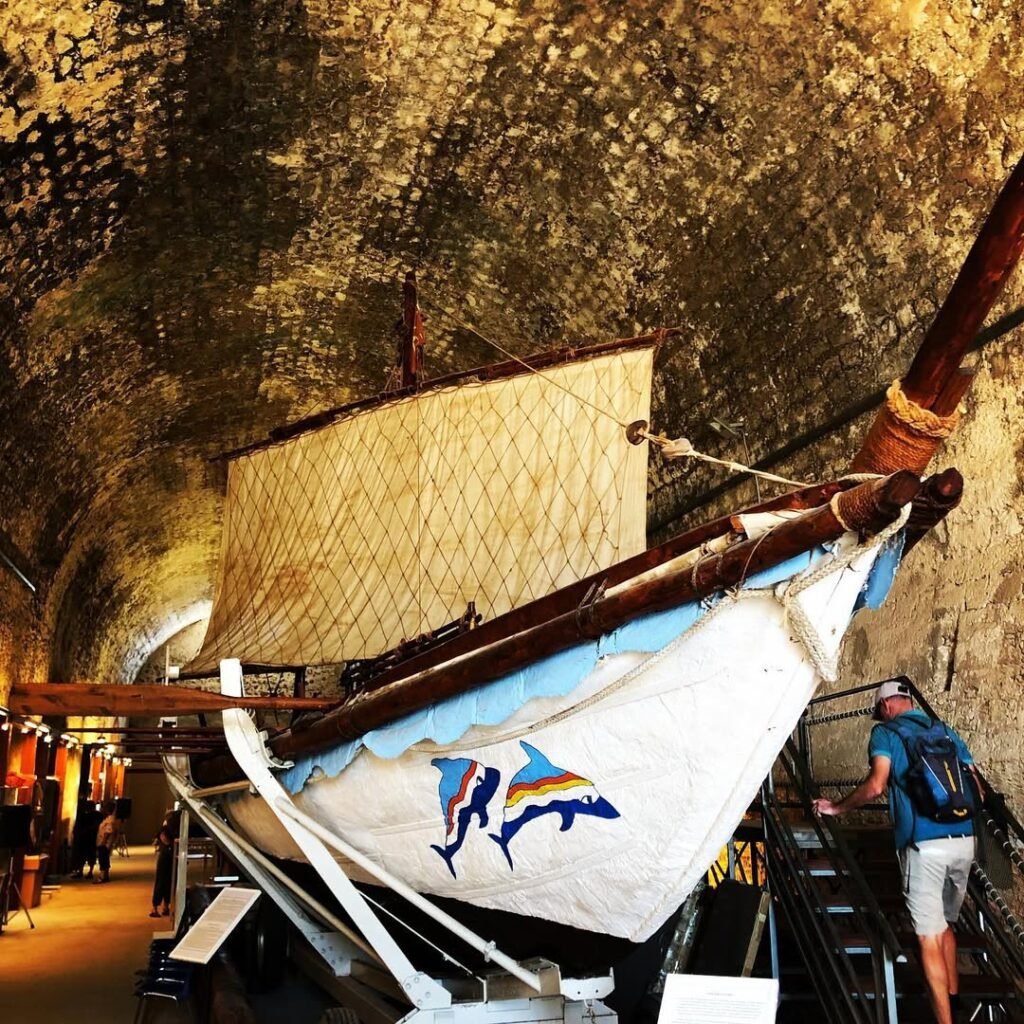
The museum’s crown jewel, the full-scale, 17-meter “Minoa” Minoan ship replica that sailed from Chania to Piraeus in 2004, is located at the Museum of Ancient and Traditional Shipbuilding in the Moro Shipyard. This annex also features additional exhibits on ancient and traditional Cretan shipbuilding.
The Setting: Located in Chania’s picturesque harbor, the museum perfectly complements a waterfront stroll or a meal at nearby tavernas. The Firka Fortress itself is a historic site, famously where the Greek flag was first raised in 1913 to mark Crete’s union with Greece, and it tells the story of the island’s strategic maritime importance through the centuries.
Practical Tips:
- Time needed: 1–2 hours for the full experience
- Accessibility: The ground floor of the main museum is step-free, but the upper floor requires stairs
- Cost: Modest entrance fee (4–5 euros, with reduced rates and a combined ticket for both sites available)
- Hours: Main museum typically open Monday–Saturday, 09:00–16:00 (closed Sundays and public holidays); Moro Shipyard annex has similar but sometimes shorter hours
- Bonus: If you’re lucky, you can chat with the in-house model-building team
- Note: The chronological exhibits make it easy to follow Crete’s maritime journey through time
Whether you’re a maritime history buff or just looking to enrich your stroll around Chania’s harbor, the Maritime Museum of Crete offers an engaging and educational window into the island’s seafaring soul.
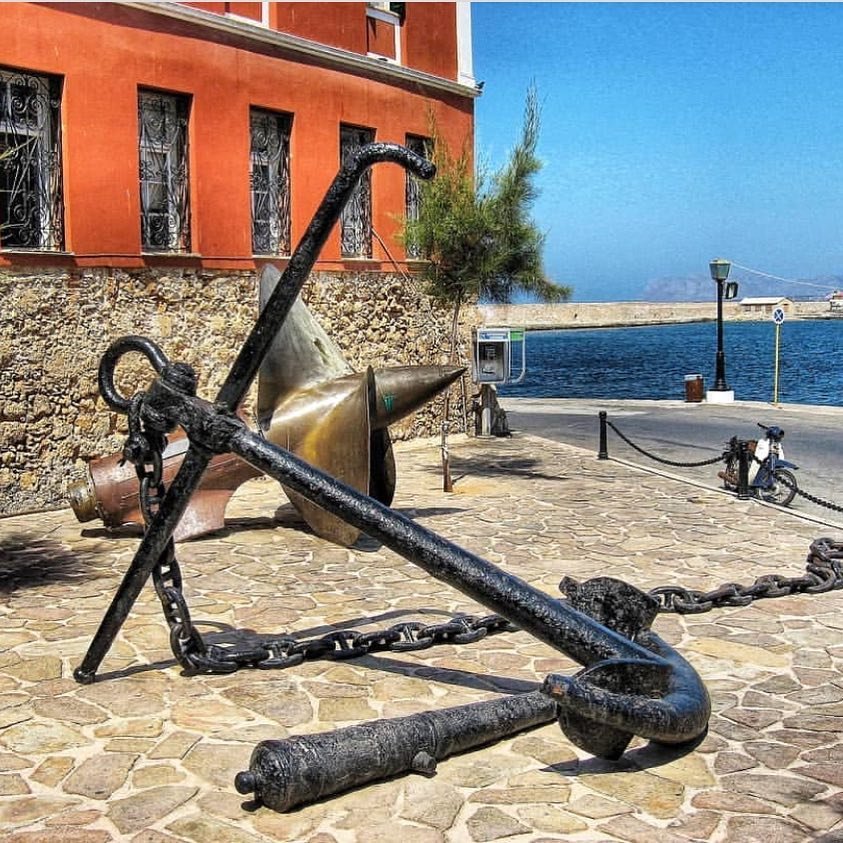
8. The Historical Museum of Crete [Heraklion]
Seventeen centuries of Cretan history come alive within the elegant neoclassical mansion of Andreas and Maria Kalokerinos, just a short walk from Heraklion’s harbor. Founded in 1953 by the Society of Cretan Historical Studies, this cultural gem chronicles the island’s journey from the early Christian era through the 20th century, all within a beautifully preserved building dating to 1903.
What You’ll See: The museum’s crown jewels are two original El Greco paintings—“Baptism of Christ” and “View of Mt. Sinai and the Monastery of St. Catherine”— the only works by the artist remaining on Cretan soil. Don’t miss the stunning 4×4 meter model of 17th-century Chandax (Venetian Heraklion), offering a bird’s-eye view of the city during its golden age. The museum also boasts an impressive numismatic collection spanning from Roman coins to modern Greek banknotes, including rare revolutionary bonds from the 1905 Theriso uprising.
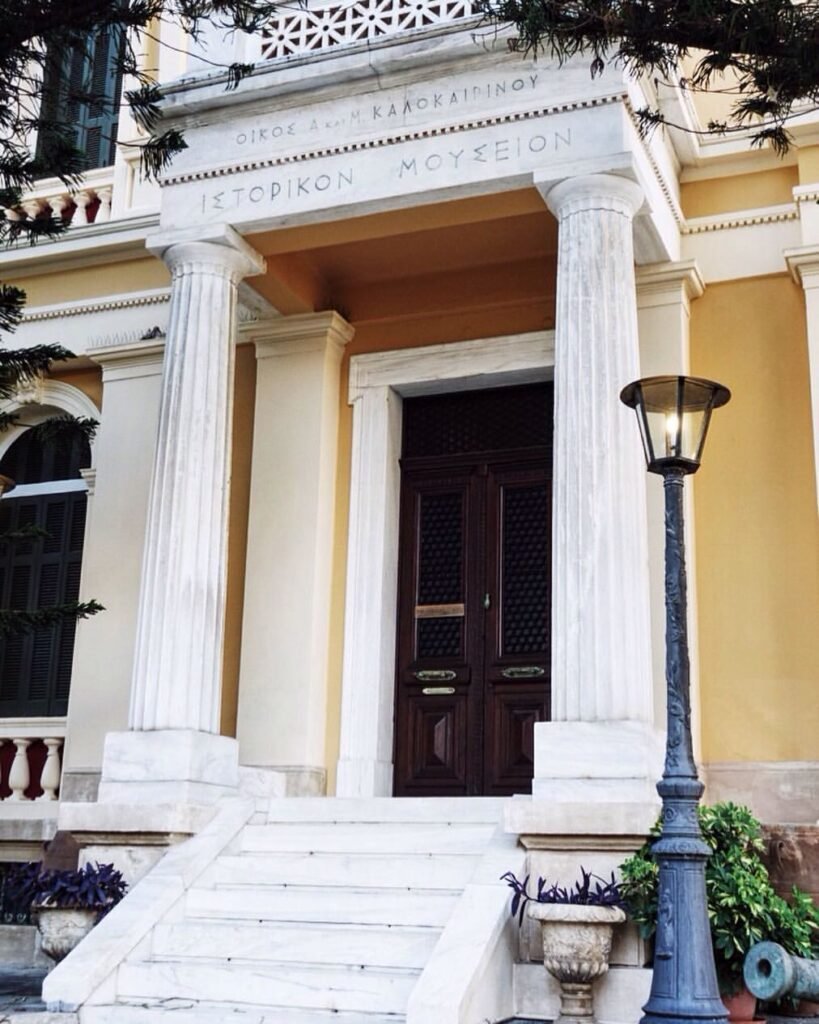
Special Spaces: Step into Nikos Kazantzakis’s actual study, transported from his home in Antibes, France, complete with his personal library and manuscripts. You’ll also find reconstructed interiors of a traditional Cretan rural home and extensive ethnographic collections that bring daily island life to vivid reality.
The Experience: Interactive touch screens and multimedia displays bring history to life across 25 themed rooms covering 1,500 square meters. Families appreciate the special children’s guide with puzzles and games, making learning engaging for younger visitors.
Practical Tips:
- Time needed: 1–2 hours minimum for the full experience
- Best for: History lovers who want context and artifacts in one place
- Location: Short walk from Heraklion’s main square and harbor
- Hours: April–October: Monday–Saturday 09:00–17:00 (closed Sundays and public holidays); shorter winter hours
- Accessibility: Fully accessible with ramps and elevators
- Family bonus: Interactive displays and dedicated children’s materials
The Historical Museum of Crete is a must for anyone seeking to understand Crete’s complex and fascinating past in one accessible, beautifully curated setting.
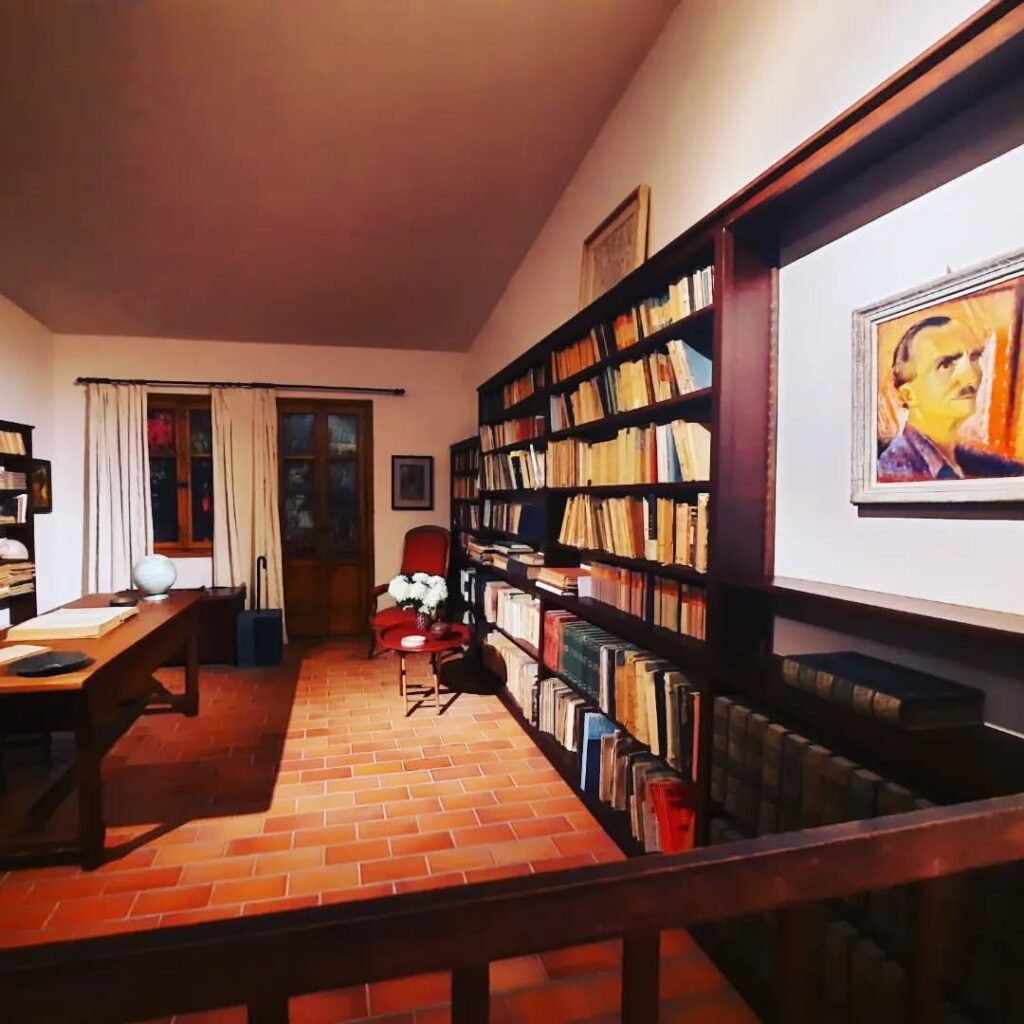
9. Natural History Museum of Crete [Heraklion]
Nestled in a converted power plant near Heraklion’s seafront, this Mediterranean’s largest natural history museum brings Crete’s diverse ecosystems to life through immersive experiences you won’t find anywhere else. With 3,500 square meters across four main floors, it’s where industrial history meets natural wonders.
What You’ll See: Marvel at the life-sized Deinotherium, a prehistoric elephant that once roamed these lands standing over 4.5 meters tall and 7 meters long, making it the largest land mammal ever found on the island. Full-scale dioramas recreate Cretan and Eastern Mediterranean habitats so realistically you’ll feel transported. The “Living Museum” features live reptiles and amphibians native to the region.
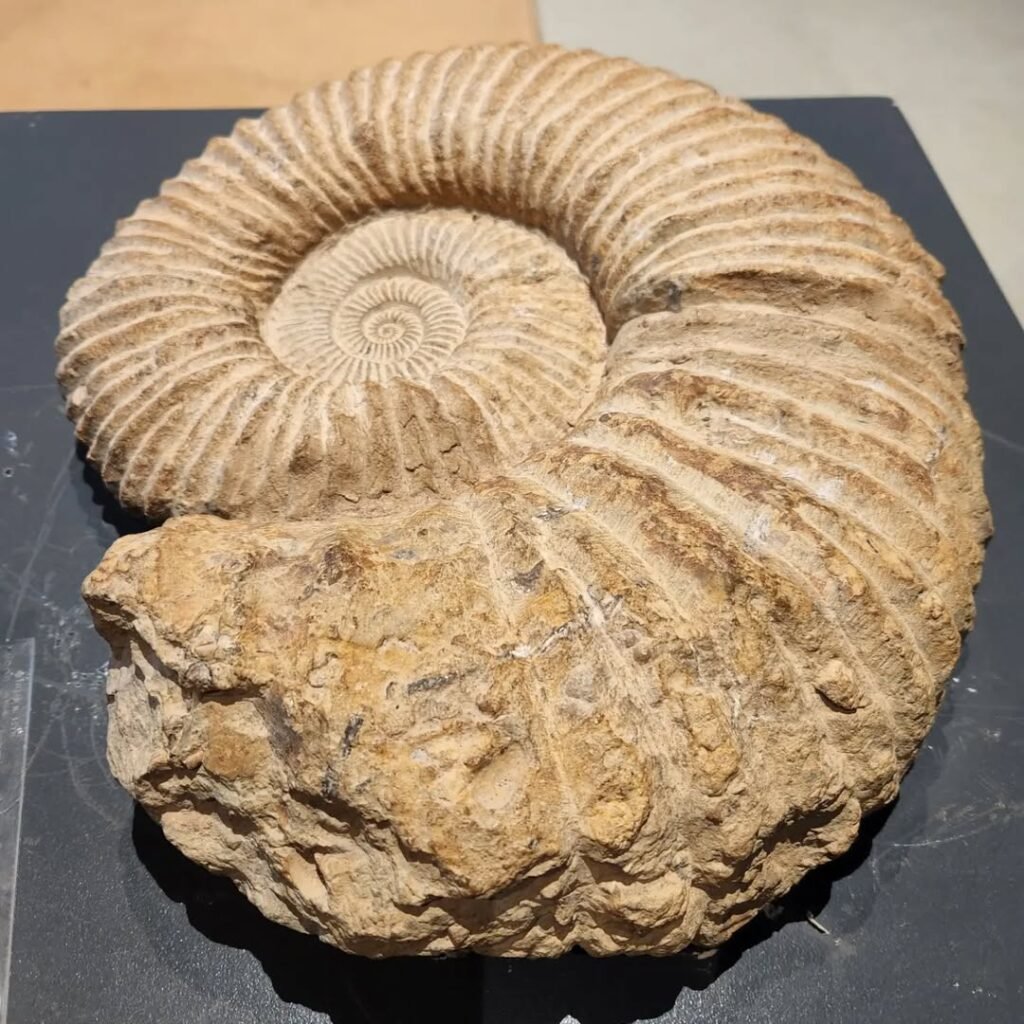
Interactive Highlights: Test your nerves in the “Enceladus” earthquake simulator, which safely recreates real seismic events up to 7.6 on the Richter scale, followed by an educational safety briefing. Kids will love the “Erevnotopos” Discovery Centre, a 250 m² interactive area where they can dig for fossils, explore minerals, and experience hands-on science activities.
Special Features: The museum regularly hosts temporary exhibitions. Recent highlights have included “Extreme Dinosaurs” with animatronic creatures and “Light Mysteries” featuring optical illusions and holography. All exhibits are labeled in both Greek and English.
Practical Tips:
- Time needed: 1.5-2 hours (families may need longer)
- Perfect for: Children and families seeking interactive learning
- Location: On Sofokli Venizelou Avenue, a short walk from the harbor (consider a taxi for the return trip)
- Note: Can get warm inside, so dress accordingly
- Hours: Summer (May–Oct): Mon–Fri 09:00–17:00, Sat–Sun 10:00–18:00; Winter (Nov–Apr): Mon–Fri 09:00–15:00, Sat–Sun 10:00–18:00
- Accessibility: The museum is accessible, but some areas may require assistance for those with mobility issues

10. Lychnostatis Open-Air Museum [Hersonissos]
Lovingly built by hand in 1992 by ophthalmologist-turned-folklorist Yiorgos Markakis, this seaside cultural paradise spans approximately 7,000 square meters where traditional Cretan life springs to life through authentic, hands-on experiences. This isn’t just a museum to observe but a living space where visitors can touch, taste, and try centuries-old traditions.
What You’ll Experience: Lychnostatis Open-Air Museum‘s four main collections include reconstructed traditional homes, a chapel, shepherd’s shelters, and working olive presses alongside extensive gardens of native herbs and fruit trees. Try your hand at centuries-old crafts like weaving, ceramics, and plant-dyeing while local artisans share their secrets in hands-on workshops.
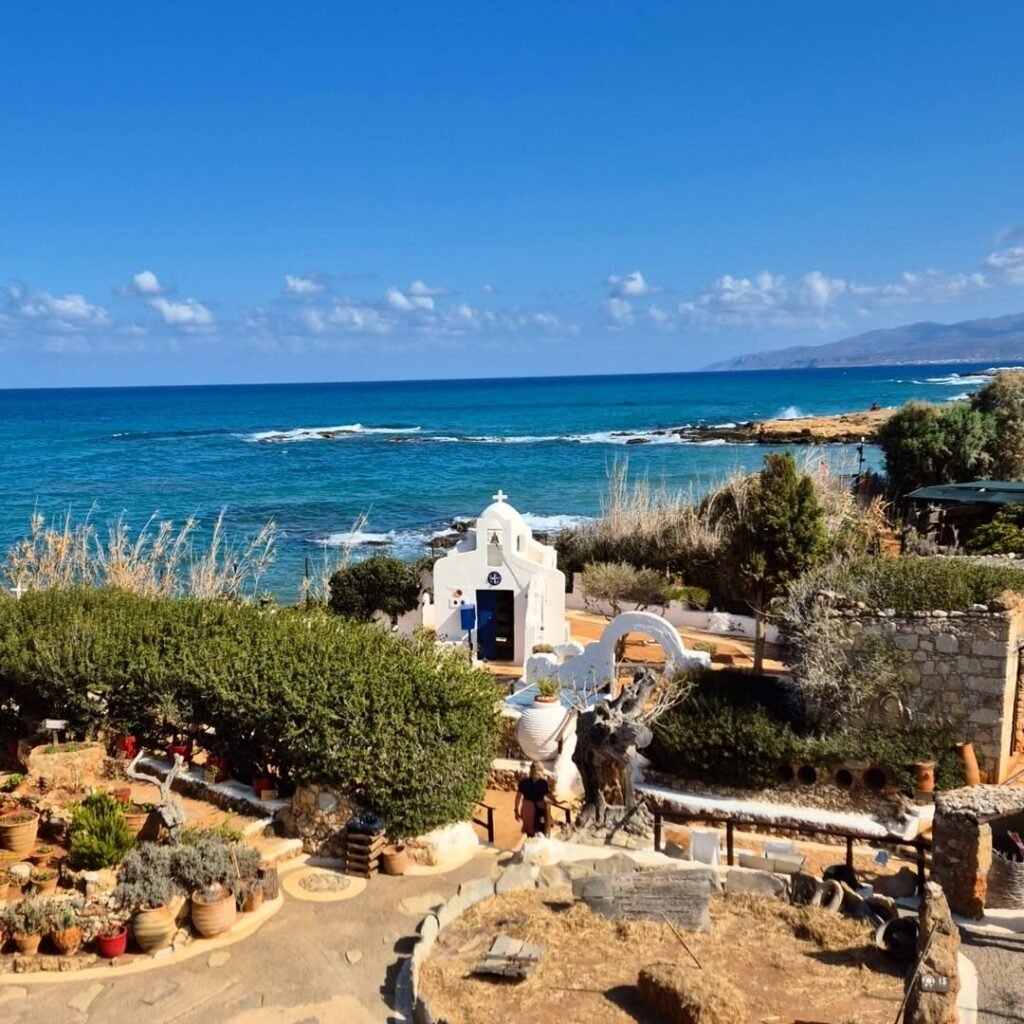
Interactive Highlights: Kids love exploring the old schoolroom, playing with traditional toys, and observing bees through a glass hive. The carob mill invites interaction, while aromatic herb gardens encourage touching and smelling. An introductory film (available in several languages) movingly explains the museum’s origins and construction.
Special Features: The 250-seat open-air theater and beachfront café create perfect spots to sample homemade raki at the traditional distillery or sip Cretan herbal tea while gazing at the Mediterranean. On special activity days, often Wednesdays but varying seasonally, enjoy Greek dancing, craft demonstrations, and complimentary snacks.
Practical Tips:
- Time needed: 1.5-3 hours depending on activities
- Audio guide: Highly recommended for deeper understanding
- Family-friendly: Exceptionally welcoming for children
- Shop: Local honey, herbs, and crafts support the museum’s mission
- Recognition: Nominated for European Museum of the Year Award in 2010
This family-run treasure, supported by a dedicated team, embodies the warm spirit of Cretan hospitality and community.

11. The Kostas Kotsanas Technology Museum [Heraklion]
Housed in the historic Palazzo d’Ittar in Heraklion’s old town, this fascinating museum brings ancient Greek innovation to life through interactive technology that’ll make you rethink what the Greeks were capable of. With around 60 fully functional replicas of ancient inventions, this hands-on experience proves that innovation isn’t just a modern concept.
What You’ll Experience: Operate the world’s first robot (Philon’s automatic servant), marvel at Heron’s automatic theater, and examine a working replica of the Antikythera Mechanism (humanity’s earliest analog computer). The friendly staff demonstrates these incredible machines, and you’re encouraged to try them yourself. Kids especially love the ancient vending machines, water organs, and even an early form of cinema.
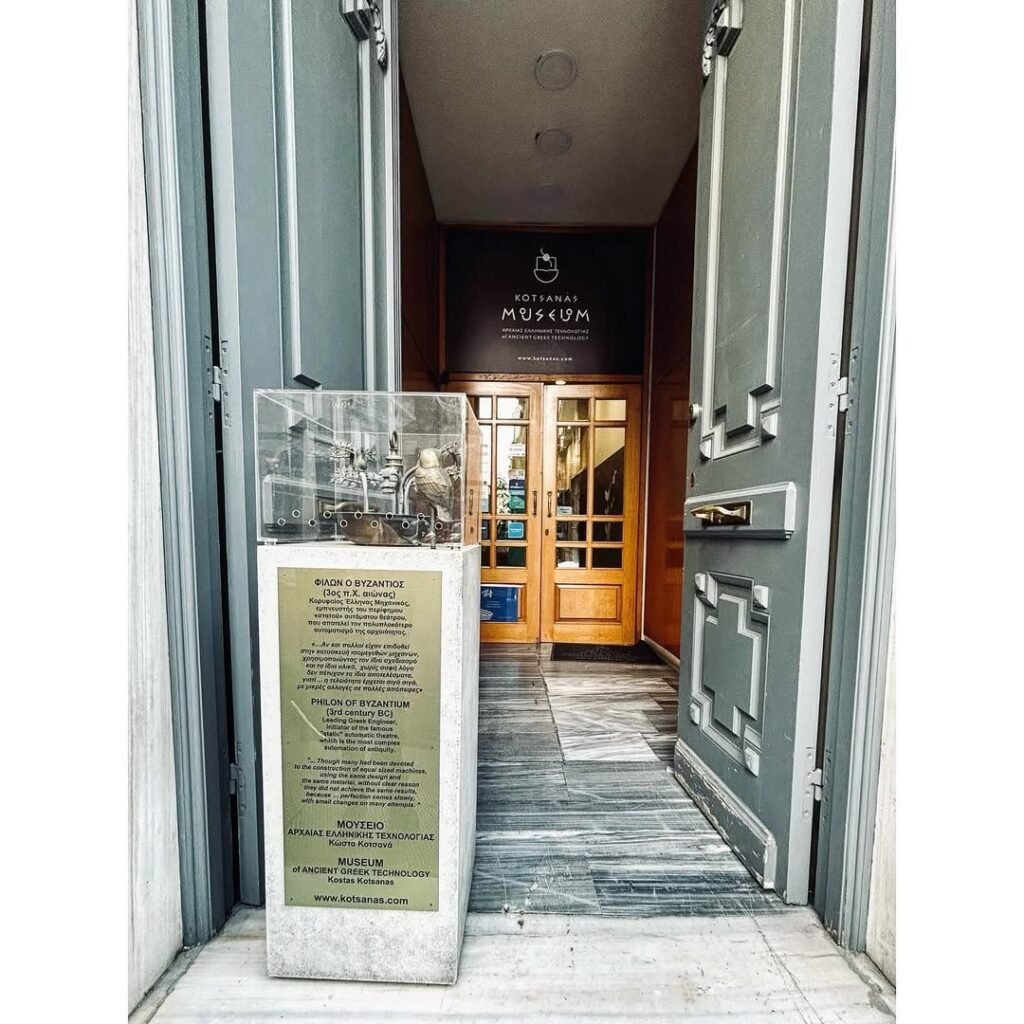
Interactive Highlights: Beyond the technology, you can listen to reconstructed ancient Greek musical instruments and play traditional board games both in the museum and at the upstairs café. The experience becomes even richer with supporting videos, diagrams, and thorough English explanations for every exhibit.
The Research: All models stem from 30 years of research by founder Kostas Kotsanas, who reconstructed these devices using ancient Greek, Latin, and Arabic texts plus archaeological finds. This scholarly dedication earned the Kotsanas Museum a 2019 European Museum of the Year nomination.
Practical Tips:
- Time needed: 1-2 hours for the full interactive experience
- Perfect for: Curious minds of all ages, especially families
- Shop bonus: Take home replicas of ancient gadgets and board games
- Café treat: When open, the upstairs café is a great spot for drinks and traditional games
- Educational programs: Check for regular workshops on robotics and ancient science
This museum transforms ancient history into an engaging, hands-on adventure that challenges everything you thought you knew about Greek innovation.
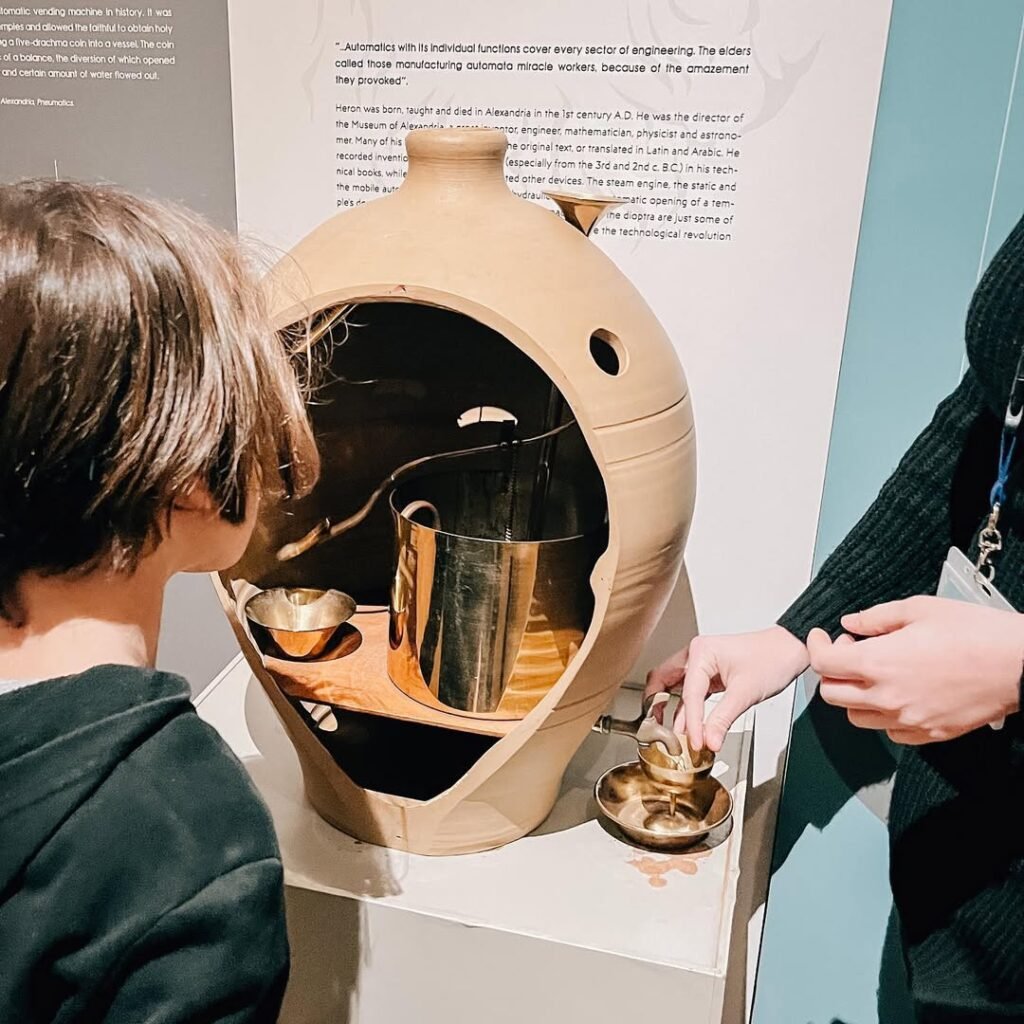
12. The Archaeological Museums of Lassithi [Agios Nikolaos, Sitia & Ierapetra]
In eastern Crete’s Lassithi region, three remarkable archaeological museums form a “golden triangle” of ancient treasures, offering intimate encounters with artifacts spanning from the Neolithic era to Roman times.
Agios Nikolaos Museum: Founded in 1969 and located near the port and Lake Voulismeni, this museum houses over 30,000 objects from excavations across eastern Crete. Highlights include the skull of a crowned athlete from ancient Lato, still adorned with a gold wreath and a coin in his mouth for Charon, and the celebrated “Goddess of Myrtos”, an Early Minoan libation vessel from Myrtos-Phournou Koryfi. The collection also features pottery, jewelry, and tools from Minoan to Roman times. Note: The museum has recently undergone renovations; check ahead for opening status and hours.
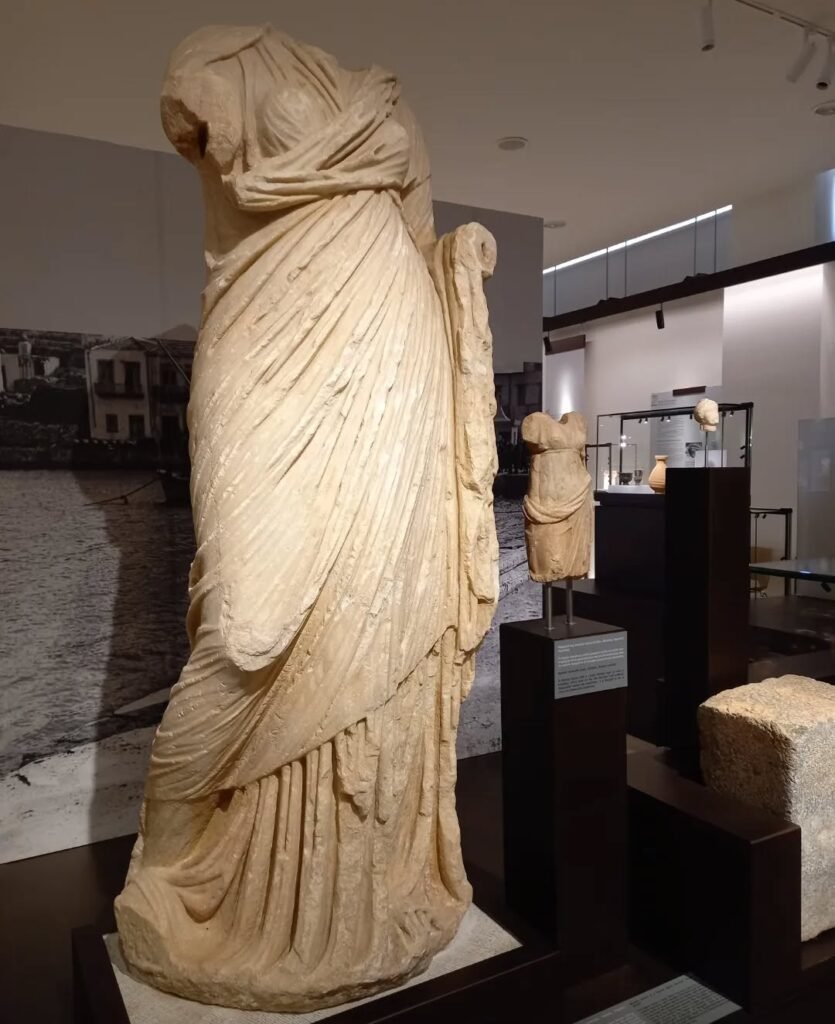
Sitia Museum: Opened in 1984 at the entrance of Sitia, this modern museum displays finds from 3500 BC to 500 AD. Its most famous exhibit is the gold and ivory “Kouros of Palekastro,” a masterpiece of Minoan art. Other treasures include artifacts from the palace of Kato Zakros, Linear A tablets, and vases from a Roman shipwreck. Exhibits are well-labeled in English and grouped thematically for easy exploration.
Ierapetra Museum: Housed in the historic Ottoman Commercial School (Mehtepi, built 1899), this collection showcases artifacts from Early Minoan to Roman periods, including pottery, coins, marble sculptures, and inscriptions. The standout is the painted clay sarcophagus from Episkopi (Late Minoan III, c. 1300 BC), decorated with scenes of daily life. The museum also features important ancient treaties and marble statues such as Demeter-Isis.
Collective Story: Together, these museums paint a vivid picture of eastern Crete’s journey from Minoan gold diadems and libation vessels to Roman statues and Hellenistic inscriptions.

Practical Tips:
- Check ahead: Agios Nikolaos Museum may have limited opening due to renovations
- Time needed: 1-2 hours per museum
- Admission: €10 (Agios Nikolaos), €5 (Sitia & Ierapetra)
- Best approach: Combine with town walks and local meals
- Accessibility: Recent upgrades in Agios Nikolaos; check each museum for details
- Hours: Typically Tuesday–Sunday, 08:30–15:00, closed Mondays
13. Alkiviades Skoulas (Grillios) Art Collection [Anogeia]
Hidden away in the mountain village of Anogeia, this remarkable collection showcases over 100 compelling works by Skoulas, who didn’t pick up a brush until age 70, yet captured Crete’s soul through vivid paintings and sculptures. His artwork depicts everything from dramatic war scenes to intimate portraits of villagers, all reflecting the island’s rugged landscapes and resilient spirit.
What You’ll See: Skoulas’s deeply personal perspective on Cretan resistance and rural life comes alive through paintings of local war scenes, historical figures, and fellow villagers. His woodcarvings and stone sculptures complement the paintings, creating a comprehensive view of traditional Cretan culture through the eyes of a true local artist.
The Experience: The museum, housed next to the artist’s former home in Anogeia’s Perachori area, offers an intimate, appointment-only experience. Skoulas’s son Yiorgos often provides personal tours and may treat visitors to impromptu lyra performances, blending visual art with Crete’s living musical traditions.
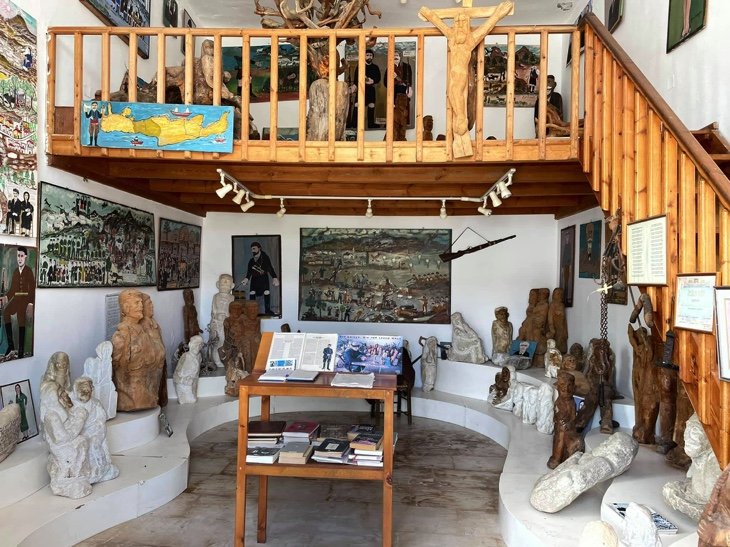
Inspiring Legacy: What makes this collection especially moving is Skoulas’s late-blooming creativity. Starting his artistic journey at 70, he serves as an inspiration for lifelong learning and the idea that it’s never too late to pursue your passion.
Practical Tips:
- Essential: Call ahead (+30 28340 31593) to arrange your free visit (donations welcome)
- Time needed: 30-60 minutes for the collection plus any musical performances
- Location: Short uphill walk from Anogeia’s lower village square
- Perfect combo: Combine with the Nikos Xilouris House and local weaving studios
- Currently: Undergoing renovations to enhance facilities
This peaceful cultural stop offers quiet reflection away from busier tourist routes, celebrating both artistic vision and village life.
14. Wartime Memories: The Askyfou War Museum [Chania Region]
Founded by Georgios Hatzidakis, who began collecting artifacts at age 14 after experiencing WWII trauma as a child, this family-run museum houses over 2,000 items that tell deeply personal stories of Cretan resistance and sacrifice. Located in the mountainous village of Kares, in the Askyfou plateau, about 50 km south of Chania, this collection transforms historical artifacts into vivid memories.
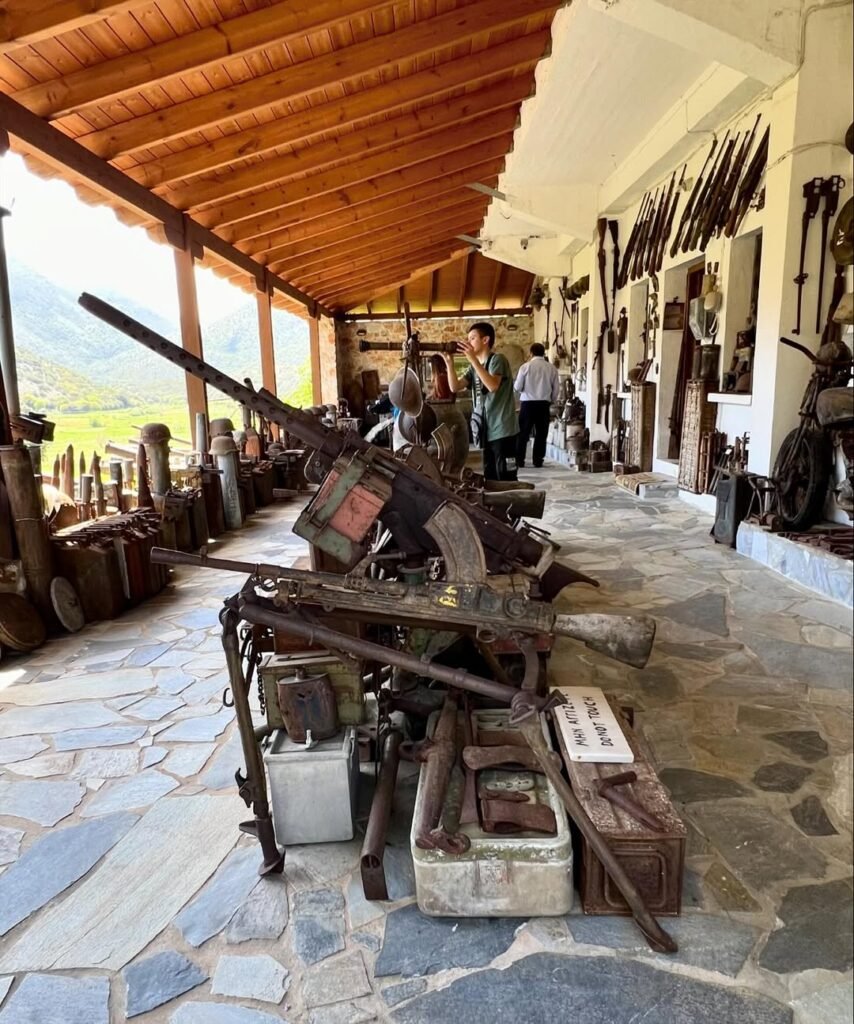
What You’ll See: The museum’s treasures range from a 1770 cannon (the oldest artifact) to a massive German bomb (the largest), plus the propeller of a German Stuka shot down during the Battle of Crete. Personal items, documents, and photographs complement the weaponry, creating a moving narrative that goes far beyond military hardware.
The Experience: What makes this museum extraordinary are the personal guided tours led by Andreas Hatzidakis or his daughters, who transform each visit into an immersive oral history session. The collection spills from interior rooms to the driveway and porch, creating an almost collage-like effect that brings history to life. Visitors often receive complimentary raki during tours, embodying true Cretan hospitality.
Historical Context: The museum sits along the historic “Via Dolorosa” route that Allied troops took during their 1941 retreat to Sfakia, adding powerful context for understanding the Battle of Crete and its aftermath.
Practical Tips:
- Admission: Donation-based, supporting this self-funded family operation
- Hours: Typically daily 8:00–21:00 in summer (shorter in winter); call ahead to confirm
- Experience: Allow time for stories about each artifact’s origins
- Growing collection: Constantly expanding as locals donate new finds
This poignant site of remembrance offers one of Crete’s most personal and moving historical experiences.

15. Local Heroine: The Kritsotopoula Museum [Kritsa, Lassithi]
While many museums celebrate grand battles and famous rulers, the Kritsotopoula Museum tells an extraordinary tale of a young woman’s courage that’ll captivate your imagination. According to local legend, in this beautifully preserved 19th-century home, you’ll discover the incredible story of Rodanthi Christodoulaki (“Kritsotopoula”), a priest’s daughter who escaped forced marriage to an Ottoman pasha, disguised herself as a male warrior named “Spanomanolis,” and fought in the Cretan resistance until her death in 1823.
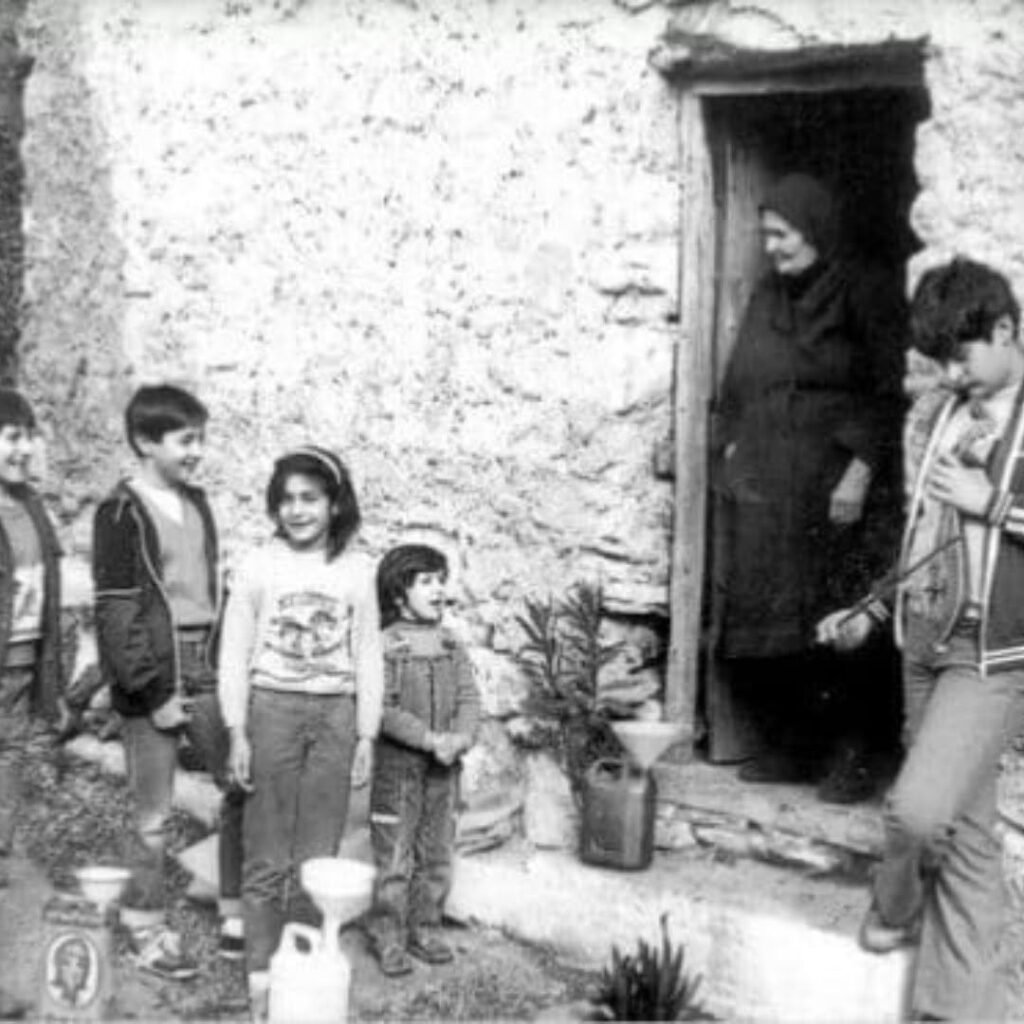
What You’ll See: The museum, believed to be her family’s home, faithfully recreates 19th-century village life through meticulously restored rooms, including Rodanthi’s bedroom, a traditional kitchen, and a period-style kafenion. Authentic furnishings include a loom with homemade textiles, local costumes, and everyday tools that bring this remarkable woman’s world to life.
The Experience: What makes your visit truly special is Maria, a descendant of Rodanthi herself, who often leads tours sharing intimate family stories that transform historical facts into compelling personal narratives. Her storytelling brings the legendary heroine’s courage and sacrifice into vivid focus.
Village Context: Kritsa celebrates Rodanthi’s legacy throughout the village with a statue by sculptor Nigel Ratcliffe on the main street and monuments at battle sites. The village’s famous embroidery and weaving traditions continue today in artisan shops lining the main road.
Practical Tips:
- Time needed: 30-45 minutes for the house plus village exploration
- Hours: Monday–Saturday 10:00–15:00/16:00 (advance booking recommended in winter)
- Admission: Free entry (donations welcome)
- Perfect combo: Visit the nearby Church of Panagia Kera with its ancient frescoes
- Shopping: Browse handmade textiles as unique souvenirs
This intimate museum celebrates both women’s bravery and the enduring spirit of Cretan resistance.
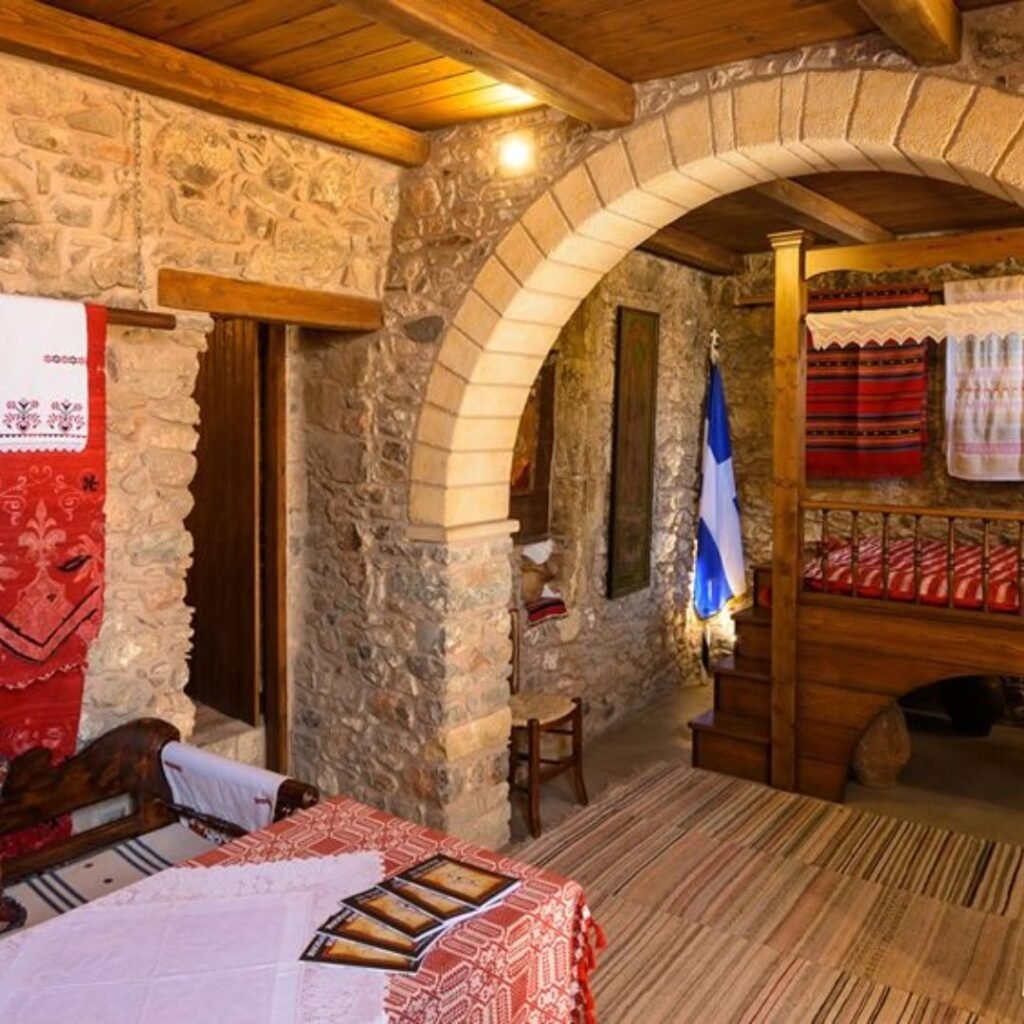
16. Monumento Kefalas [Kefalas, Apokoronas]
Set along the rural road between Kefalas and Vamos, Monumento Kefalas is one of Crete’s most distinctive open-air art environments. Created by local artist Vangelis Vlepakis, this evolving stone monument stands as a testament to personal vision and Cretan folk creativity.
What You’ll See: Monumento Kefalas is a sprawling outdoor installation made entirely by hand from local stone, terracotta, and found materials. The site features a series of religious niches, crosses, mosaics, and symbolic sculptures, each blending traditional Cretan motifs with the artist’s unique, imaginative style. Inscriptions calling for the protection of nature (“Love the Forest”) and playful spiritual elements invite visitors to discover new details with every visit. (Note: The chapel dedicated to Agios Phanourios is located at the artist’s other site, the House of Stone Creations, in Kefalas.)

The Experience: Vlepakis began work on Monumento Kefalas in the 1990s, and the site remains freely accessible at any time, just park by the roadside and wander among the sculptures at your own pace. The monument’s peaceful setting, with panoramic views of the Apokoronas countryside, makes it a tranquil stop away from Crete’s busier attractions.
If you’d like to meet the artist, hear his stories, or learn more about his creative process, you may find him at his nearby House of Stone Creations in Kefalas village, where he is often present to greet visitors.
Practical Tips:
- Time needed: 20–40 minutes to explore
- Admission: Free, with donations welcome
- Location: On the road from Kefalas to Vamos, about 700 meters from Kefalas village center (look for “Monumento Kefalas” or “Stone Museum” on Google Maps)
- Hours: Open-air and accessible at any time
- Accessibility: Uneven terrain; not suitable for those with limited mobility
- Bonus: Combine with a stroll through Kefalas village or a visit to the nearby House of Stone Creations
Monumento Kefalas offers a unique, off-the-beaten-path encounter with Cretan creativity and folk spirituality—a living testament to the power of individual artistic vision on the island.
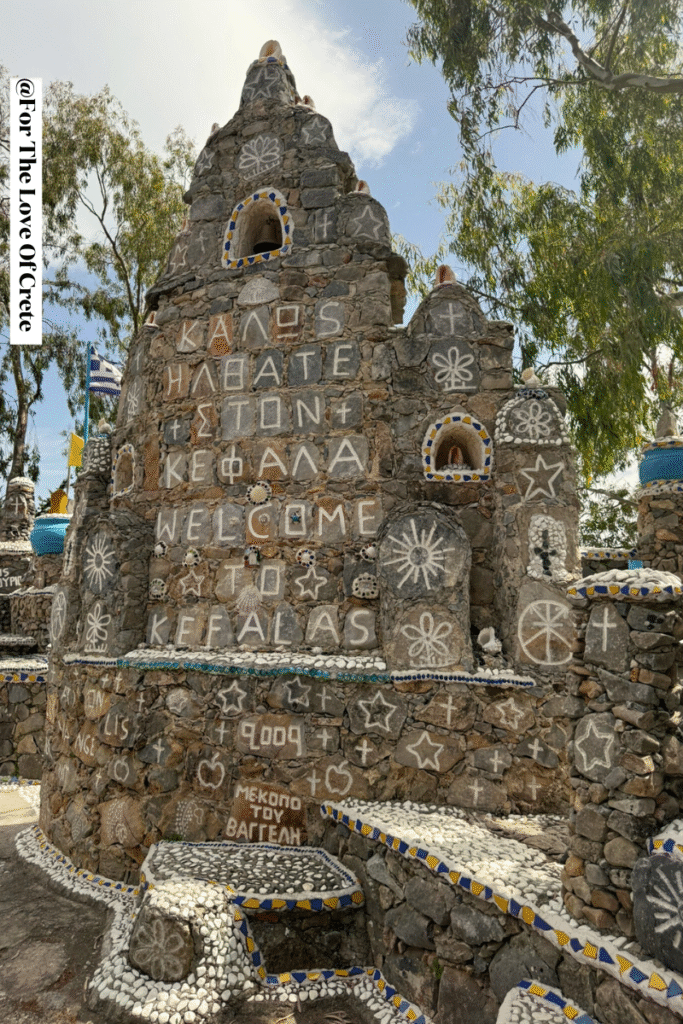
Conclusion
Crete’s museums aren’t just buildings filled with artifacts; they’re gateways to the island’s soul, offering an incredible diversity that spans from world-class archaeological treasures at Heraklion to intimate family stories at the Kritsotopoula Museum. Whether you’re fascinated by ancient Minoan mysteries, moved by wartime resistance tales, or enchanted by traditional crafts coming to life, these 16 cultural sanctuaries showcase the island’s layered history and vibrant present. The passion of local communities, families, and individuals who preserve and share Cretan heritage shines through every exhibit, making each visit a deeply personal encounter with authentic island culture.
Even seasoned Crete lovers will discover something new with each visit, as museums regularly update exhibits, host special events, and offer fresh perspectives on familiar stories. Support these cultural treasures through entrance fees, donations, and museum shop purchases that fund preservation and educational programs. Every museum visit becomes a step deeper into Crete’s remarkable tapestry, where ancient history, living traditions, and modern innovation weave together to create experiences that will transform how you see Greece’s largest island.
Further reading:
Cretan Mountain Partisans: The Unsung Heroes of World War II Resistance
The Ancient Knossos Palace in Crete: Guide to a Minoan Wonder
